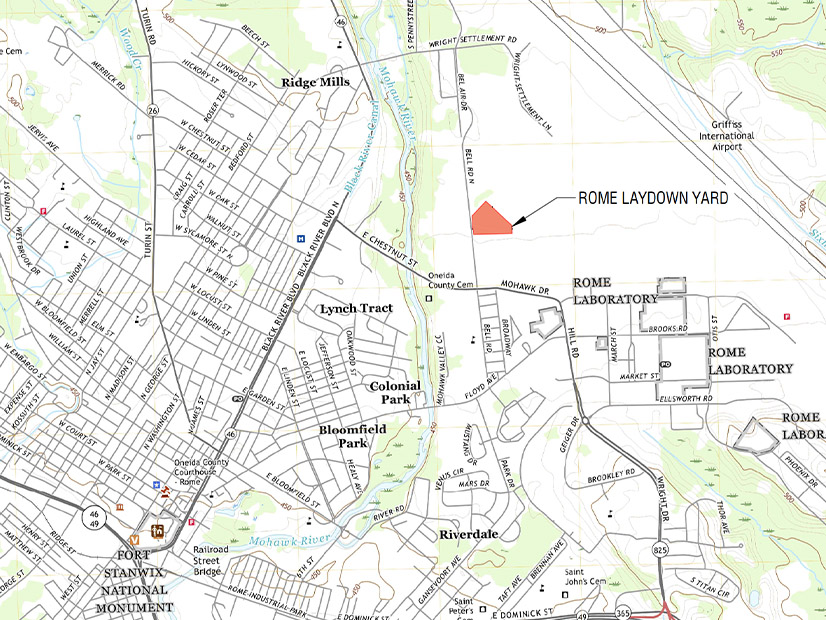
New York’s departments of Agriculture and Markets (AGM), Public Service (DPS), and Environmental Conservation (DEC) this month approved a joint proposal by them, the New York Power Authority (NYPA) and National Grid (NYSE:NGG) for completion of phase 2 of the 100-mile Smart Path transmission line rebuild project (21-T-0340).
The Smart Path project is part of NYPA’s $1 billion Northern New York transmission line, which the Public Service Commission in October 2020 designated as a high priority for meeting the state’s renewable energy goals, bypassing NYISO’s public policy transmission planning process (20-E-0197). (See NYPSC OKs NYPA Project, ‘Priority’ Tx Criteria.)
The AGM said that its concerns and issues were addressed in the proposal and its appendices.
“Environmental impacts have been minimized by siting the proposed transmission line within existing rights of way to the greatest extent practicable,” it said. “Because the project predominantly uses existing ROW, there will be virtually no discernable change in land-use conditions along the transmission line portion of the project. Additionally, the project represents the minimum adverse impact on active farming operations, considering the state of available technology and the nature and economics of alternatives and other pertinent considerations.”
The DEC said that “there are no further issues for litigation concerning the application.”
John B. Donahue, a resident of Lyons Falls, about 30 miles north of the city of Rome, had commented June 8 that he and his wife, Bonnie, “are all for the upgrade to the power lines, but then they said they wanted another 12.5 feet of our property; we were taken by surprise because it sounded like it was a done deal and we had nothing to say about it. I know this project is huge and entails hundreds of miles of ROW and 12.5 feet is not very much, but this would severely impact our lives here.”
In its letter of approval a week later, the DPS commented that Donahue’s concerns will be addressed through project design changes made during development of the environmental management and construction plan that no longer require expansion of the ROW onto his property.
“The only remaining property acquisition at this location would be National Grid’s acquisition of danger tree rights in order to comply with the proposed certificate conditions should they be adopted by the commission,” DPS staff said.
A danger tree is defined by the commission as “any tree rooted outside of a ROW that due to its proximity and physical condition … poses a particular danger to a conductor or other key component of a transmission facility.”
By definition, a danger tree must exist outside of the ROW. Therefore, any necessary acquisition of danger tree rights would not constitute an expansion of the ROW and would only give National Grid the right to remove any trees that pose a risk to the transmission line, the DPS said.
Attorney Thomas S. West, representing the town of Burke, submitted a letter June 16 stating that the town is not able to support the proposal, as there are still outstanding issues under negotiation concerning the resolution of issues associated with potential impacts to local roads.
“We are in negotiations with NYPA and hope to conclude those negotiations in the near term. In the absence of finalizing those negotiations in a manner acceptable to the town, we reserve all rights to request a hearing concerning road impact issues,” West said.
National Grid proposes leasing 7 acres of paved, but unused, runway at the Griffiss International Airport in Rome as one of two staging areas for Smart Path project construction.
Marcy resident Thomas N. Rastani Jr. commented June 24 that the project’s design more than doubles the height of the transmission towers, to 135 feet, which would make them “clearly visible from the road approaching my home, or anywhere on my property.”
In addition, increasing the voltage capacity from 230 kV to 345 kV for two lines will increase the noise levels substantially, along with an increase in electromagnetic waves, he said.
“Overall, this proposed line will disrupt the wildlife (which is why I purchased this property to begin with); it will disrupt the quality of life during construction; and it will leave a lasting impact with the increased electromagnetic waves and increased noise pollution that myself and my neighbors will be forced to endure,” Rastani said.

